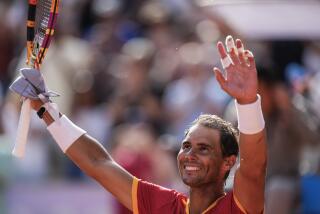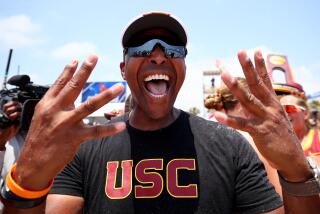TENNIS : Byron Black Making a Name for Himself, and Doing It His Way
- Share via
It’s a long way from Zimbabwe to Exposition Boulevard, where an avocado farmer’s son from Harare found USC and a chance at the pros.
Only three years ago, Byron Black was a struggling young player with aspirations of making it big on the tennis court. He had left his home in Zimbabwe to seek tougher competition and wound up at John Newcombe’s tennis academy in New Braunfels, Tex.
Black wrote to a number of college tennis coaches, including Dick Leach of USC, to find a school that wanted him. It wasn’t easy.
“(Leach) didn’t know me,” Black said.
Then in the U.S. Open juniors, Black beat Al Parker, the then-top-ranked American, and Leach quickly became interested.
“But he didn’t have a scholarship (to give),” Black said.
When Black defeated Nduka Odizor of Nigeria in a 1987 Davis Cup match, everything changed.
“Coach found a scholarship,” Black said.
And here it is only October, and Black has already started on next year. Recently, the USC junior won the first major men’s tennis tournament of the season, the Bay Point collegiate clay-court event, and established himself as one of the players to watch in the 1990 college season.
Black, 5-feet-8 and 138 pounds, teamed with Eric Amend to win the National Collegiate Athletic Assn. doubles championship last season. The No. 3 singles player a year ago, Black will play No. 1 singles this season, which means this baselining counterpuncher who hits two-fisted from both sides is right where he wants to be.
“I like pressure,” Black said. “When you play No. 1 singles, you get to play all the other best players. When I played No. 3, I couldn’t get excited. I knew I wasn’t playing the best player. My adrenaline didn’t flow.”
If he intends to make an impact in the pros, Black may be forced to volley one-handed, but he doesn’t think it’s going to happen, no matter how hard he tries to alter his style.
A business major, Black intends to earn his degree before turning pro. He said he’s only being pragmatic.
“It’s tough out there in the pros,” he said. “If I don’t make it, well, it’s paid for here. I might as well get it and then turn pro. I would have to come back here and pay and I don’t have the money.
With Amend gone, Black will be looking for a new doubles partner this year, and neither he nor Leach has made a decision yet. Black said he already has a candidate for his doubles partner in the pros--former USC player Scott Melville.
As for Black changing his style, he’s in no mood for it.
“I’ve been hitting it two-handed for 17 years,” Black said. “There’s no way of changing it.”
USC is the host school for the 1990 NCAA Division I men’s championships May 18-27 at Hyatt Grand Champions.
Georgia has played host to the event for the last 13 years in Athens, Ga., but Leach led a group of college tennis coaches who persuaded the NCAA men’s tennis committee to seek another site.
“Some of the coaches felt that having the tournament at one site over an extended period of time gave the host team a decided ‘home-court’ advantage,” Leach said.
How badly does Ivan Lendl want to win Wimbledon?
After arriving in Sydney for the Australian Indoor championships, Lendl said he would sacrifice his No. 1 ranking next year and every tournament except one if he could make his dream come true and win Wimbledon.
Lendl reaffirmed his decision to train on grass courts in Australia with coach Tony Roche and sit out the French Open, even if it meant his No. 1 ranking would be passed on to Boris Becker.
“I am more worried about winning in England,” said Lendl, who was beaten by Becker in the semifinals there this year. “If I can win in England, he (Becker) can win everything else. That’s fine with me.”
Lendl, who came to Australia with his bride of three weeks, the former Samantha Frankel, said he was happy with a year that included one Grand Slam victory in the Australian Open. Lendl lost in the semifinals of Wimbledon and the final of the U.S. Open--both times to Becker.
“My goal at the start of the year was to win one of the two Grand Slams I hadn’t won, and I did that in Melbourne,” he said.
They made spectacles of themselves: Without so much as lifting a racket, the Soviet Federation Cup team was a winner in Tokyo.
The Soviet women, clad in black sunglasses, miniskirts and denim jackets with CCCP on the back, won the Federation Cup’s elegance award in the opening ceremony parade for the 40-nation event. Unfortunately, they weren’t as stunning on the court, where they lost to Spain in the quarterfinals.
The So-What? Dept.: Forty-eight of the top 50 men’s tennis players have signed to play on the new Assn. of Tennis Professionals tour, which begins next year, the ATP announced.
The only two players who had not committed to play on the tour by the Sept. 11 deadline were Jimmy Connors and Thomas Muster of Austria, according to the ATP, which gave both players extensions.
This seemed something of a hollow announcement by the ATP, which becomes the only men’s pro tennis game next year. Where else are the players going to play?
R.E.H. (Buzzer) Hadingham, chairman for the last six years of the All England Club, which runs the Wimbledon tournament, will retire in December.
Hadingham, who will be 74 when he retires at the club’s annual general meeting Dec. 14, said in a letter to friends and tennis associates that it is time “for a younger person to take over.”
Under Hadingham’s leadership, covered courts and clay practice courts have been built and the grounds extended, and the “Last Eight” club was created for Wimbledon quarterfinalists.
It was also Hadingham who stepped in and banned John McEnroe from the Queen’s Club in London after McEnroe swore at two wives of All England Club members. Hadingham rescinded that ban of McEnroe this summer during the Wimbledon championships.
Tennis Notes
Stanford is ranked No. 1 among men’s teams in the preseason Volvo rankings, with Georgia No. 2 and UCLA No. 3. UC Irvine is No. 9. USC is not ranked in the top 25, although junior Byron Black is No. 13 in singles. The top-ranked men’s singles player is Mike Brown, a junior at Arkansas. Shige Kanroji and Trevor Kronemann of UC Irvine comprise the No. 1-ranked men’s doubles team. . . . Stanford is also the No. 1-ranked women’s team with its top player, junior Sandra Birch, No. 1 in singles. UCLA, ranked No. 2, is led by Jessica Emmons, No. 2 in singles. Stanford has won four consecutive NCAA women’s tennis titles, as well as the last two men’s championships.
More to Read
Fight on! Are you a true Trojans fan?
Get our Times of Troy newsletter for USC insights, news and much more.
You may occasionally receive promotional content from the Los Angeles Times.






